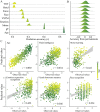A Neuroimaging Signature of Cognitive Aging from Whole-Brain Functional Connectivity
- PMID: 35811304
- PMCID: PMC9403648
- DOI: 10.1002/advs.202201621
A Neuroimaging Signature of Cognitive Aging from Whole-Brain Functional Connectivity
Abstract
Cognitive decline is amongst one of the most commonly reported complaints during normal aging. Despite evidence that age and cognition are linked with similar neural correlates, no previous studies have directly ascertained how these two constructs overlap in the brain in terms of neuroimaging-based prediction. Based on a long lifespan healthy cohort (CamCAN, aged 19-89 years, n = 567), it is shown that both cognitive function (domains spanning executive function, emotion processing, motor function, and memory) and human age can be reliably predicted from unique patterns of functional connectivity, with models generalizable in two external datasets (n = 533 and n = 453). Results show that cognitive decline and normal aging both manifest decrease within-network connections (especially default mode and ventral attention networks) and increase between-network connections (somatomotor network). Whereas dorsal attention network is an exception, which is highly predictive on cognitive ability but is weakly correlated with aging. Further, the positively weighted connections in predicting fluid intelligence significantly mediate its association with age. Together, these findings offer insights into why normal aging is often associated with cognitive decline in terms of brain network organization, indicating a process of neural dedifferentiation and compensational theory.
Keywords: biomarker; brain age; cognition aging; individualized prediction; predictive neuroimaging.
© 2022 The Authors. Advanced Science published by Wiley-VCH GmbH.
Conflict of interest statement
The authors declare no conflict of interest.
Figures







References
Publication types
MeSH terms
Grants and funding
LinkOut - more resources
Full Text Sources
